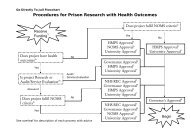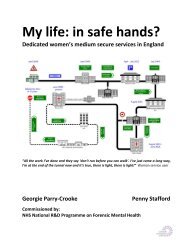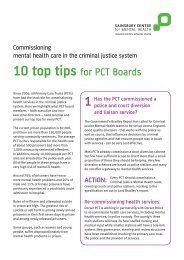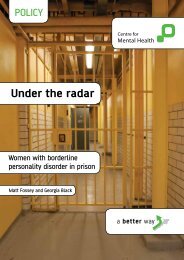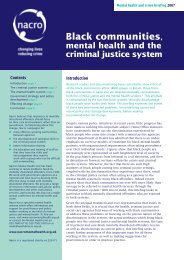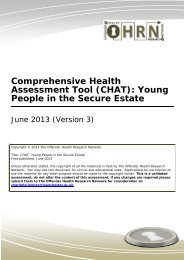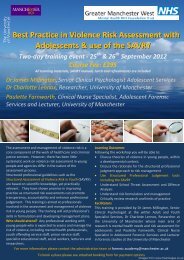Physical Control in Care Training Manual - Independent Advisory ...
Physical Control in Care Training Manual - Independent Advisory ...
Physical Control in Care Training Manual - Independent Advisory ...
Create successful ePaper yourself
Turn your PDF publications into a flip-book with our unique Google optimized e-Paper software.
PHYSICAL CONTROL IN CAREOur objective when deal<strong>in</strong>g with an aggressive young person is toprevent the aggression escalat<strong>in</strong>g <strong>in</strong>to actual physical violence.Signs of aggression:• Stand<strong>in</strong>g tall• Red faced• Raised voice• Rapid breath<strong>in</strong>g• Direct prolonged eye contact• Exaggerated gesturesWhy does aggression occur?• Frustration• Perceived unfairness• Feel<strong>in</strong>gs of humiliation• Immaturity• Excitement• Learned behaviour (it gets results)• Means to an end• DecoyAssess<strong>in</strong>g the risk of violence and aggression:Consider the follow<strong>in</strong>g questions, the more often the answer is “yes”,the greater the risk of violence or aggression:• Is the young person fac<strong>in</strong>g a high level of stress? (e.g. a recentbereavement, a pend<strong>in</strong>g court date)• Does the young person seem to be drunk or on drugs?• Does the young person have a history of violence?• Does the young person have a history of psychiatric illness?• Has the young person verbally abused staff <strong>in</strong> the past?• Has the young person threatened staff with violence <strong>in</strong> thepast?Recognis<strong>in</strong>g potential aggression at an early stage:The follow<strong>in</strong>g signs may <strong>in</strong>dicate aggression:© National Offender Management Service National Tactical Response GroupJuly 201021



